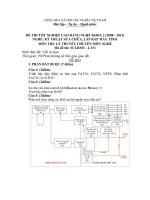PASSAGE 31
Bạn đang xem bản rút gọn của tài liệu. Xem và tải ngay bản đầy đủ của tài liệu tại đây (42.82 KB, 3 trang )
PASSAGE 31
In the early 1800s, less than 3% of the world's population lived in cities; today, more than half of the
global population is urban and by 2050, the proportion will rise to three quarters. There are thousands of
small and medium-sized cities along with more than 30 megacities and sprawling, networked
metropolitan areas — conurbations — with 15 million residents or more. Yet despite these massive
transformations in how people live and interact, our international affairs are still largely dictated by nation
states, not cities.
Cities are beginning to flex their muscles on the international stage. They are already displacing nation
states as the central nodes of the global economy, generating close to 80% of global GDP. Cities like New
York and Tokyo are bigger in GDP terms than many G-20 countries.
Metropolitan regions and special economic zones are linking global cities through transnational supply
chains. A growing number of mega-regions, such as those linking cities in Mexico and the US, transcend
borders. In the process, cities are collectively forging common regional plans, trading partnerships, and
infrastructure corridors.
The spectacular rise of cities did not happen by accident. Cities channel creativity, connect human capital,
and when well governed, they drive growth. That many cities and their residents are rolling up their
sleeves and getting things done — where nations have failed — are grounds for optimism. In the future,
we hope that it is our proximate, accountable, and empowered city leaders who will define our fates.
Question 1. What is the passage mainly about?
A. History of cities all over the world
B. Types of cities in the world
C. Contributions of cities to the world
D. The not-to-distant future of cities
Question 2. Which of the following is NOT true according to the writer?
A. Humanity transitioned from a rural to a primarily urban species at breathtaking speed
B. Cities are the dominant form of human civilization in the 21st century.
C. There is a tendency for cities to connect to form large urban regions.
D. People should not be too optimistic about the future of cities.
Question 3. The phrase “flex their muscles” in paragraph 2 is closest in meaning to __________.
A. show their strength B. change their attitudes C. leave their side
D. find their ways
Question 4. Would the following sentence best be placed at the end of which paragraph?
This is neither fair nor rational.
A. Paragraph 1
B. Paragraph 2
C. Paragraph 3
D. Paragraph 4
Question 5. The word “they” in paragraph 4 is refers to ___________.
A. plans
B. partnerships
C. cities
D. residents
Page 1
ĐÁP ÁN
1-C
2-D
3-A
4-A
5-C
LỜI GIẢI CHI TIẾT
Question 1:
Ý chính của bài là gì?
A. Lịch sử của các thành phố trên tồn thế giới
B. Các loại thành phố trên thế giới
C. Đóng góp của các thành phố với thế giới
D. Tương lai không xa của các thành phố
=>Dẫn chứng: Cities are beginning to flex their muscles on the international stage. They are already
displacing nation states as the central nodes of the global economy, generating close to 80% of global
GDP. Cities like New York and Tokyo are bigger in GDP terms than many G-20 countries.
Dich: Các thành phố đang bắt đầu thể hiện sức mạnh của họ trên trường quốc tế. Chúng đã thay thế các
quốc gia, là nút trung tâm của nền kinh tế toàn cầu, tạo ra gần 80% GDP toàn cầu. Các thành phố như
New York và Tokyo lớn hơn về GDP so với nhiều quốc gia G-20.
Question 2:
Điều nào sau đây là khơng đúng theo người viết?
A. Lồi người chuyển từ nơng thơn sang lồi chủ yếu ở thành thị với tốc độ chóng mặt
B. Thành phố là hình thức thống trị của nền văn minh nhân loại trong thế kỷ 21.
C. Có xu hướng các thành phố kết nối để hình thành các khu vực đơ thị lớn.
D. Mọi người không nên quá lạc quan về tương lai của các thành phố.
=> Dẫn chứng; (A) In the early 1800s, less than 3% of the world's population lived in cities; today, more
than half of the global population is urban and by 2050, the proportion will rise to three quarters.
(B) The spectacular rise of cities did not happen by accident. Cities channel creativity, connect human
capital, and when well governed, they drive growth. That many cities and their residents are rolling up
their sleeves and getting things done — where nations have failed — are grounds for optimism
(C) Metropolitan regions and special economic zones are linking global cities through transnational
supply chains..
Dịch: (A) Vào đầu những năm 1800, ít hơn 3% dân số thế giới sống ở các thành phố; ngày nay, hơn một
nửa dân số toàn cầu là thành thị và đến năm 2050, tỷ lệ này sẽ tăng lên ba phần tư.
(B) Sự trỗi dậy ngoạn mục của các thành phố đã khơng xảy ra một cách tình cờ. Sáng tạo kênh thành phố,
kết nối vốn nhân lực và khi được quản lý tốt, họ thúc đẩy tăng trưởng. Rằng nhiều thành phố và cư dân
của họ đang xắn tay áo và hồn thành cơng việc - nơi các quốc gia thất bại - là cơ sở cho sự lạc quan
(C) Các khu vực đô thị và đặc khu kinh tế đang liên kết các thành phố tồn cầu thơng qua các chuỗi cung
ứng xuyên quốc gia ..
Question 3:
Cụm từ “flex their muscles”, trong đoạn 2 có nghĩa gần nhất với __________.
A. thể hiện sức mạnh của họ
B. thay đổi thái độ
C. rời khỏi phe họ
D. tìm đường
Page 2
=> Dẫn chứng: Cities are beginning to flex their muscles on the international stage.
Các thành phố đang bắt đầu thể hiện sức mạnh của chúng trên trường quốc tế.
Question 4:
Câu sau đây tốt nhất sẽ được đặt ở cuối đoạn nào?
Điều này không công bằng cũng không hợp lý.
A. Đoạn 1
B. Đoạn 2
C. Đoạn 3.
D. Đoạn 4
=> Dẫn chứng: In the early 1800s, less than 3% of the world's population lived in cities; today, more than
half of the global population is urban and by 2050, the proportion will rise to three quarters. There are
thousands of small and medium-sized cities along with more than 30 megacities and sprawling,
networked metropolitan areas — conurbations — with 15 million residents or more. Yet despite these
massive transformations in how people live and interact, our international affairs are still largely dictated
by nation states, not cities.
Dịch: Có hàng ngàn thành phố vừa và nhỏ cùng với hơn 30 siêu đô thị và trải dài, các khu vực đô thị
được nối mạng - các khu đô thị - với 15 triệu cư dân trở lên. Tuy nhiên, bất chấp những thay đổi lớn trong
cách mọi người sống và tương tác, các vấn đề quốc tế của chúng ta vẫn chủ yếu được quyết định bởi các
quốc gia, chứ không phải các thành phố.
Question 5:
Từ “they” trong đoạn 4 được dùng để chỉ ___________.
A. kế hoạch
B. quan hệ đối tác
C. thành phố
D. cư dân
=> Dẫn chúng: Cities channel creativity, connect human capital, and when well governed, they drive
growth.
Dịch: Sáng tạo các kênh thành phố, kết nối vốn nhân lực và khi được quản lý tốt, chúng sẽ thúc đẩy tăng
trưởng.
Page 3









